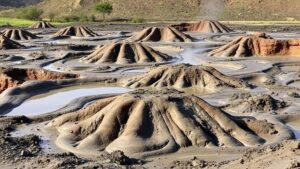Exploring myths of the “Golden City of the Sierra Nevada,” hidden in Colombia’s mountains.
Exploring Myths of the Golden City of the Sierra Nevada
Legend has it that nestled in the Sierra Nevada mountains of Colombia lies a city of gold, a mythical place known as El Dorado. This famed city has captivated explorers and treasure hunters for centuries, spawning numerous myths and legends that blur the lines between history and fantasy. El Dorado is often depicted as a paradise overflowing with treasures, particularly gold, attracting adventurers and dreamers alike.
The Origins of the El Dorado Legend
The myth of El Dorado can be traced back to the indigenous Muisca tribe, who inhabited the Altiplano Cundiboyacense region of Colombia. According to the legend, their leader, the Zipa, would cover himself in gold dust and make offerings of gold and jewels into Lake Guatavita as part of sacred rituals. These accounts of opulence were circulated by Spanish conquerors in the 16th century, amplifying the allure of a city overflowing with wealth.
Geographical Context
The Sierra Nevada de Santa Marta, where this golden city is believed to be hidden, is the highest coastal mountain range in the world, rising sharply from the Caribbean Sea. This unique geographical feature, with peaks reaching 5,775 meters (18,947 feet), creates a challenging and isolated environment. Much of the area is difficult to access, with dense jungles and steep terrains, which has helped preserve its secrets over the centuries.
Historical Expeditions
Throughout history, numerous expeditions have set out to find El Dorado, often with disastrous results. Notable expeditions include:
- Gonzalo Jiménez de Quesada (1536): He led a significant expedition into the interior of Colombia, driven by tales of gold. His journeys resulted in the conquest of the Muisca territory, yet he found no city of gold, only the rich culture of its people.
- Andrés de Urdaneta (1564): An experienced navigator whose quest for El Dorado took him through various terrains. Despite various discoveries, he, too, failed to locate the mythical city.
- Sir Walter Raleigh (1595): An English explorer who made several attempts to uncover the treasures of the New World, including Colombia. His expeditions highlighted the continued fascination with the myth, despite encountering harsh realities.
These expeditions highlight both the desperation and misguided ambitions of explorers during the Age of Exploration. While they brought back tales of exotic lands and colonized territories, the elusive city of El Dorado remained a tantalizing dream.
Modern Discoveries and Archaeological Insights
In recent years, archaeological efforts have begun to shed light on the myths surrounding El Dorado. discovery of significant gold artifacts, particularly around the Lake Guatavita area, challenges the notion of El Dorado as a physical city but rather places emphasis on the cultural and ritualistic significance of gold among indigenous tribes.
In 2021, archaeologists from the University of Los Andes discovered ancient gold artifacts in the Sierra Nevada, igniting new hopes of locating significant treasures. These finds suggest that the myth may have originated from actual practices and ceremonies of gold fabrication prevalent among indigenous communities.
Environmental and Ethical Considerations
The quest for El Dorado has not only led to the loss of lives but has also caused significant environmental damage. The rush for gold led to deforestation, habitat destruction, and the depletion of natural resources. Today, it is crucial to respect the ecological integrity of the Sierra Nevada while valuing the historical and cultural heritage of its indigenous peoples.
Conclusion: The Timeless Allure of El Dorado
While the Golden City of the Sierra Nevada may remain hidden, its mythology serves as a powerful reminder of the consequences of human greed and the pursuit of wealth. The tales of El Dorado resonate through generations, inspiring both cautionary tales and adventurous spirits. Understanding its origins, exploring archaeological findings, and acknowledging the cultural significance enriches our perception of this enduring legend.
As we reflect on the myths of El Dorado, it is essential to carry forward actionable takeaways, such as:
- Respect for indigenous cultures and their histories
- A commitment to environmental conservation in historically rich areas
- An understanding that many legends, while enticing, often embody deeper truths about humanitys relationship with wealth and nature.



